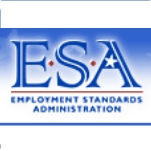The ESA was established in 1971 as the Workplace Standards Administration and changed to the Employment Standards Administration in the Department of Labor to combine major components under management of one assistant secretary and office. The Wage and Hour Division was the earliest program created by the Fair Labor Standards Act in 1938. It included minimum wage, overtime pay and child labor policy. Since then it has come to enforce many other labor acts, including the Migrant and Seasonal Agricultural Workers Protection Act and the Family and Medical Leave Act. The Office of Federal Contract and Compliance was formed in 1965 and by 1978 included all federal government contract compliances. The Office of Workers’ Compensation Program began with an organization created in 1916 to file claims under the Federal Employees Compensation Act. It now also includes acts to protect coal miners and maritime workers and their families in cases of work-related injury, illness or death. The Office of Labor-Management Standards was first established as the Bureau of Labor-Management Reports with the 1959 Labor-Management Reporting and Disclosure Act. Its main purpose was to maintain standards in labor organizations representing employees in private industry. With the Civil Service Reform Act of 1978 and the Foreign Service Act of 1980, this office also included federal-sector unions. The office gained its current name in 1984 and became part of ESA in 1992, and was transferred back in 1996 after a brief stay at the Office of the American Workplace.
Wage and Hour Division Press Releases
- Table of Contents
- Overview
- History
- What it Does
- Where Does the Money Go
- Controversies
- Suggested Reforms
- Comments
- Leave a comment

Victoria Lipnic, a member of the Equal Employment Opportunity Commission (EEOC) who had been widely seen as a possible secretary of labor in the Donald Trump administration, instead settled for being named acting chairman of the EEOC on January 25, 2017. The EEOC is responsible for eliminating all forms of discrimination in the workplace.
Lipnic is from Carrolltown, Pennsylvania, where her father Ed, a teacher, also served as mayor. She attended Cambria Heights High School and went on to Allegheny College, where she earned a B.A. in political science and history in 1982.
Lipnic found a job in the Reagan-era Commerce Department under then-Secretary Malcolm Baldridge, ending her stint there as special assistant to the assistant secretary for trade development and the International Trade Administration.
She then went to law school at George Mason, earning her J.D. in 1991. Lipnic worked for a time as an attorney in private practice before landing a spot in 1994 with the U.S. Postal Service as their in-house counsel for employment matters. After six years there, she moved to Congress as the workforce policy counsel to the House Education and Labor Committee.
Lipnic joined the George W. Bush administration’s Department of Labor as assistant secretary for employment standards. In that position, Lipnic backed employers’ calls to weaken the Family and Medical Leave Act and pushed through a change in overtime policy that allowed employers to exempt more of their workers from earning overtime pay.
After the Bush administration left office, Lipnic worked briefly at the Seyforth Shaw law firm before being appointed to the EEOC by President Barack Obama in 2010. She was reappointed in 2015. While a member of the commission, Lipnic dissented in a decision that discrimination on the basis of sexual orientation is a form of sexual discrimination and a violation of Title VII. She also voted against a proposal requiring employers to submit detailed pay data by gender, race and ethnicity as a way of curbing pay discrimination.
Speaking at the offices of her former employer, Seyfarth Shaw, on February 9, 2017, in her first speech as acting chair, Lipnic announced that she hoped the EEOC would increase its focus on age discrimination and equal pay issues and on job creation. She also expressed her intention of having EEOC commissioners vote on more complaints before they are filed in federal court, rather than having general counsel make the decisions. The EEOC currently has a Democratic majority, but that will probably be reversed in July.
-Steve Straehley
To Learn More:
Under Trump, EEOC Will Focus on Job Growth (by Kate McGovern Tornone, HR Daily Advisor)
What Trump’s Secretary of Labor Could Do (by Alexia Fernández Campbell, The Atlantic)
- Latest News
- D.C. Public Schools will Teach all Second-Graders to Ride a Bike
- New Rule in Germany Limits Sales of Sex-Themed E-Books to 10pm to 6am
- What Happened to the 6-Year-Old Tibetan Boy the Chinese Government Kidnapped 20 Years Ago?
- U.S. Ambassador to Turkey Photoshops his Hair Color to Mock Turkish Mayor
- Mystery Artist Calls Attention to Unfixed Potholes by Drawing Penises around Them
The ESA was established in 1971 as the Workplace Standards Administration and changed to the Employment Standards Administration in the Department of Labor to combine major components under management of one assistant secretary and office. The Wage and Hour Division was the earliest program created by the Fair Labor Standards Act in 1938. It included minimum wage, overtime pay and child labor policy. Since then it has come to enforce many other labor acts, including the Migrant and Seasonal Agricultural Workers Protection Act and the Family and Medical Leave Act. The Office of Federal Contract and Compliance was formed in 1965 and by 1978 included all federal government contract compliances. The Office of Workers’ Compensation Program began with an organization created in 1916 to file claims under the Federal Employees Compensation Act. It now also includes acts to protect coal miners and maritime workers and their families in cases of work-related injury, illness or death. The Office of Labor-Management Standards was first established as the Bureau of Labor-Management Reports with the 1959 Labor-Management Reporting and Disclosure Act. Its main purpose was to maintain standards in labor organizations representing employees in private industry. With the Civil Service Reform Act of 1978 and the Foreign Service Act of 1980, this office also included federal-sector unions. The office gained its current name in 1984 and became part of ESA in 1992, and was transferred back in 1996 after a brief stay at the Office of the American Workplace.
Wage and Hour Division Press Releases
Comments

Victoria Lipnic, a member of the Equal Employment Opportunity Commission (EEOC) who had been widely seen as a possible secretary of labor in the Donald Trump administration, instead settled for being named acting chairman of the EEOC on January 25, 2017. The EEOC is responsible for eliminating all forms of discrimination in the workplace.
Lipnic is from Carrolltown, Pennsylvania, where her father Ed, a teacher, also served as mayor. She attended Cambria Heights High School and went on to Allegheny College, where she earned a B.A. in political science and history in 1982.
Lipnic found a job in the Reagan-era Commerce Department under then-Secretary Malcolm Baldridge, ending her stint there as special assistant to the assistant secretary for trade development and the International Trade Administration.
She then went to law school at George Mason, earning her J.D. in 1991. Lipnic worked for a time as an attorney in private practice before landing a spot in 1994 with the U.S. Postal Service as their in-house counsel for employment matters. After six years there, she moved to Congress as the workforce policy counsel to the House Education and Labor Committee.
Lipnic joined the George W. Bush administration’s Department of Labor as assistant secretary for employment standards. In that position, Lipnic backed employers’ calls to weaken the Family and Medical Leave Act and pushed through a change in overtime policy that allowed employers to exempt more of their workers from earning overtime pay.
After the Bush administration left office, Lipnic worked briefly at the Seyforth Shaw law firm before being appointed to the EEOC by President Barack Obama in 2010. She was reappointed in 2015. While a member of the commission, Lipnic dissented in a decision that discrimination on the basis of sexual orientation is a form of sexual discrimination and a violation of Title VII. She also voted against a proposal requiring employers to submit detailed pay data by gender, race and ethnicity as a way of curbing pay discrimination.
Speaking at the offices of her former employer, Seyfarth Shaw, on February 9, 2017, in her first speech as acting chair, Lipnic announced that she hoped the EEOC would increase its focus on age discrimination and equal pay issues and on job creation. She also expressed her intention of having EEOC commissioners vote on more complaints before they are filed in federal court, rather than having general counsel make the decisions. The EEOC currently has a Democratic majority, but that will probably be reversed in July.
-Steve Straehley
To Learn More:
Under Trump, EEOC Will Focus on Job Growth (by Kate McGovern Tornone, HR Daily Advisor)
What Trump’s Secretary of Labor Could Do (by Alexia Fernández Campbell, The Atlantic)
- Latest News
- D.C. Public Schools will Teach all Second-Graders to Ride a Bike
- New Rule in Germany Limits Sales of Sex-Themed E-Books to 10pm to 6am
- What Happened to the 6-Year-Old Tibetan Boy the Chinese Government Kidnapped 20 Years Ago?
- U.S. Ambassador to Turkey Photoshops his Hair Color to Mock Turkish Mayor
- Mystery Artist Calls Attention to Unfixed Potholes by Drawing Penises around Them






Comments